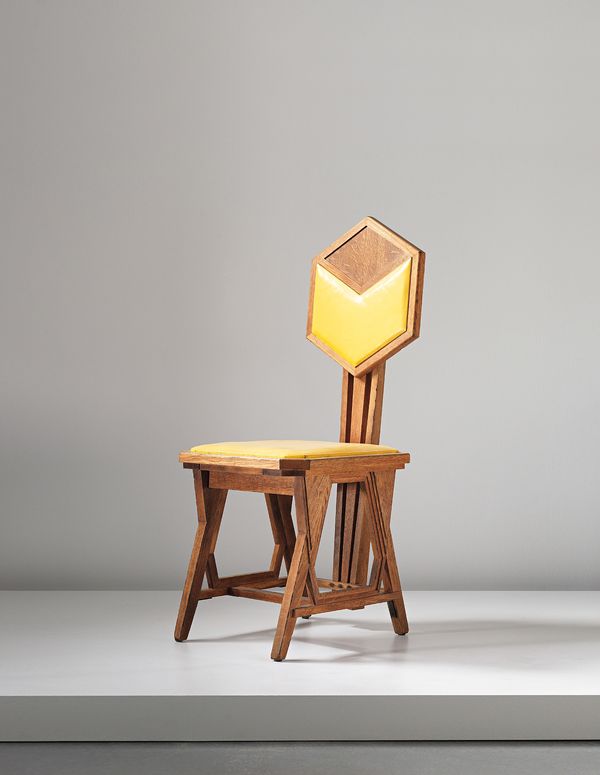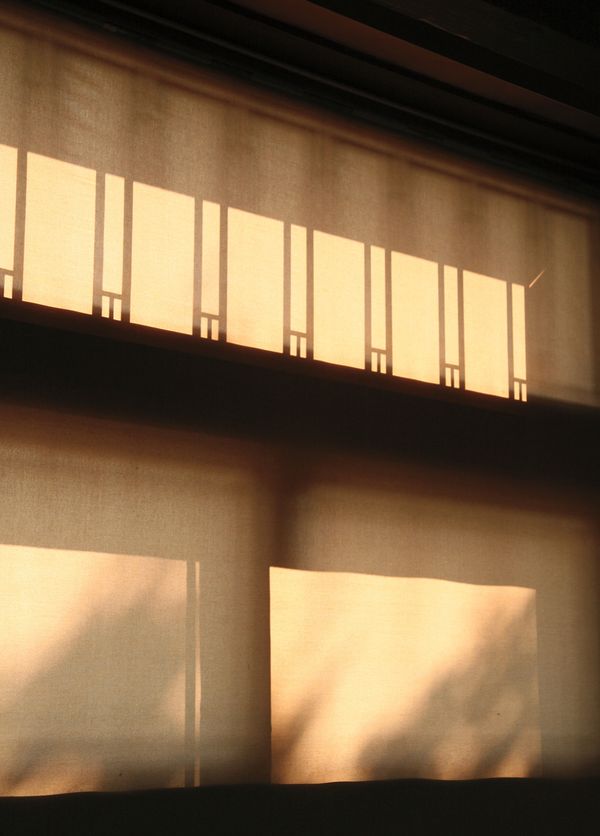Frank Lloyd Wright 'Peacock' chair, designed for the Imperial Hotel, Tokyo. Designed 1921-1922. Oak, oil cloth. Back of chair with aluminium metal label impressed 425. This piece was included in our 2014 London sale 'The Architect', curated by Lee F. Mindel, FAIA, and sold for £35,000.
In 1916 the Japanese government commissioned Frank Lloyd Wright — born 150 years ago on 8 June 1867 in Wisconsin — to design the new Imperial Hotel in Tokyo. Wright's priority was that the building be earthquake resistant, which he achieved by resting the structure on piles of concrete slabs that descended below, essentially "floating" the building on deeper layers of mud.
The hotel opened in 1922 and famously survived the devastating earthquake of 1923. As an early instance of the residential use of concrete, the commission marked a new phase of Wright's career: the departure from the Prairie school style of the previous decade and subsequent development of "Organic Architecture."
As early as 1888 in Frank Lloyd Wright's own childhood bedroom, you see the vault that foreshadows forms that he pursued throughout his long-ranging career.
— Lee F. Mindel
Frank Lloyd Wright, studio in the architect's residence, Oak Park, Ill., 1889-1898
Wright was given quite a lot of power, and the Imperial Hotel was the ultimate Gesamtkunstwerk, or "total work of art," from its elaborate H-shaped plan containing two interior gardens to the silverware in its dining room. The interior scheme is informed by Wright's concept of decorative unity, and all of the interior furnishings were designed and produced specifically for the hotel. One of the commission's standout designs, the 'Peacock' chair seen above, was featured throughout the building including in front of the fireplace in the parlor, in a special box in the theater and in the long promenade.
The hexagonally shaped back of the chair mimics the ornament of the cornice and ceiling and derives from forms found in Japanese art and design. Wright wrote in his autobiography that "Japanese fine-art traditions are among the noblest and purest in this world…The West has much to learn from the East—and Japan was the gateway to that great East of which I had been dreaming since I had seen my first Japanese prints, and read my first Laotze."
[Wright's] Imperial Hotel was the ultimate Gesamtkunstwerk.
Archival image of Wright's dramatic Mayan Revival-style Imperial Hotel, built in 1923 and demolished in 1968. The building survived 1923's Great Kantō Earthquake and the American bombing of the city during World War II. Wright created more than 700 drawings for this project.
Perhaps ironically, the chair form itself was a foreign notion in Japan at this time, and its presence demonstrates the country's efforts to westernise. In this way, the chair dually reflects both the architect's and the host country's fascination with each other.
The Imperial Hotel was demolished in 1968 in advance of the 1970 Tokyo World's fair. The lobby and entrance pool were preserved at the Meiji Mura Museum in Inyuama, Japan, and the furniture was dispersed to museums and various collections.
Examples of this chair, which came to auction at Phillips London in April 2014, can be found in the permanent collections of The Museum of Modern Art, New York, The Cooper-Hewitt, National Design Museum, New York and The Philadelphia Museum of Art.


